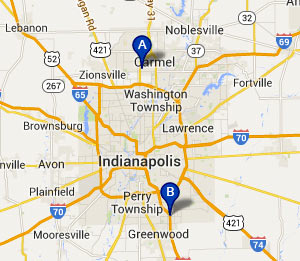Tearing in Adults
Excessive Eye Watering (Epiphora)
What Causes Excess Tearing?
Excessive tearing (epiphora) in the adult patient has many causes. Overproduction of tears may be caused by eye irritation (foreign body, wind, smoke, fumes), eyestrain, or emotion. "Dry" eyes is a actually one of the most common causes of reflex tearing. The lining of the eyelids contain numerous small glands that provide for baseline tear production to keep the surface of the eye moist during normal activities. A large tear-producing gland called the lacrimal gland is located in the upper eyelid and generally excretes large quantities of tears when the eye is irritated or "dry". This excessive amount of tear production often will not drain normally and tears will overflow and run down the cheek.
How Do Tears Normally Drain?
Tear drainage occurs through a small opening (punctum) on the inside corner of each upper and lower eyelid. After entering the punctum, tears drain through a small canal (canaliculus) into the lacrimal sac on the side of the nose, and then down the nasolacrimal duct into the nose. A poorly positioned or narrow (stenotic) punctum may prevent tears from entering the lacrimal drainage system. Narrowing or blockage of the canaliculi (for instance due to prior trauma or infection) or the nasolacrimal duct may also cause tearing (epiphora). Nasolacrimal duct obstruction predisposes to tear duct infections called Dacryocystitis. Eyelid closure and blinking has a role in "pumping" tears down the tear duct. Loose or lax lower eyelids may interfere with normal lacrimal "pump" function and result in tearing.
What is the Treatment of Excessive Tearing?
 Watch to learn more about Dacryocystorhinostomy (DCR) Surgery
Watch to learn more about Dacryocystorhinostomy (DCR) Surgery
Treatment of symptomatic tearing is guided by the suspected cause(s) of the tearing. Elimination of irritants, in-turned eyelashes, or treatment of dry eyes and blepharitis may help minimize reflex tearing (epiphora). Eyelid malposition (ectropion or retraction) or laxity (looseness) may require surgical correction. Punctal stenosis may be corrected by an office procedure to widen the punctal opening (punctoplasty). Obstruction of the nasolacrimal duct may require a procedure called a Dacryocystorhinostomy (DCR) in which bypass of the obstruction is performed by making an opening from the lacrimal sac into the nose.
Occasionally, the cause of tearing can not be determined or treatment does not fully alleviate excessive eye watering.
More information on Tearing in Adults
